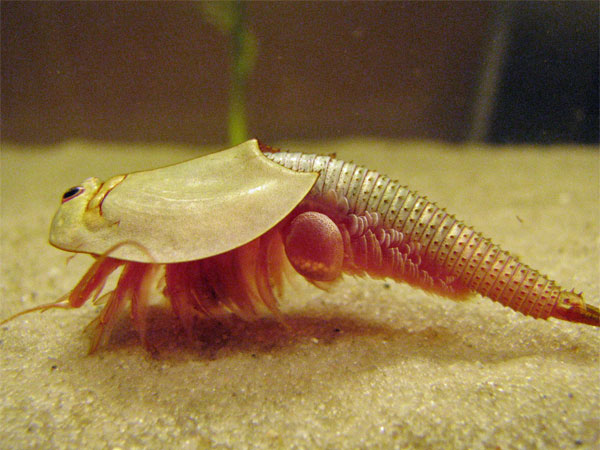Sometimes, a movie has a monster that’s biological identification is just so goofy that they either have to embrace it or hide it as best they can.
If it’s a comedy like Attack of the Killer Tomatoes it can work to blatantly advertise the silly monster.
It also works for intentional cheese-fests. But other times, the monster’s identity needs to be hidden. Because it really is hard to make a movie focus on your giant killer beastie when it’s an animal so harmless that killing them is considered a childhood pastime.
The Monster that Challenged the World is such a movie.
It has great effects and some good character actors, but when you see what they identify the monsters (or ‘Kraken’ as they call them, but it has about as much to do with that monster as its portrayal in the various Clash of the Titans films did with the original mythic source).
It’s made even worse because that identification doesn’t really work from a biological standpoint.
I mean, the puppet they use for this monster is still amazing looking, but it really can’t escape what it is.
The film is a basic take on the whole Them! concept, and shares much of its symbolism.
The creatures, however, are only radioactive by coincidence. This robs them of some of their symbolic value. They fit the cold war menace rather well: secretive, slow moving, dangerous.
The lack of a radioactive element makes them far less memorable. As an amphibious menace, they did manage to do one scene with a true ‘jaws’ moment, dragging two victims into the inky depths where humanity’s vision cannot function easily. The unknown like that is always frightening.
Biology
Here’s the big deal. The game breaker for this monster. The monster that challenged the world . . . Is a snail.
I’m serious. It’s a giant prehistoric snail.
Which is why it’s harder to take. Sure, ants are nasty and spiders are always scary regardless of size. But some animals can’t really be taken as credible threats, even when grown huge. Locusts, slugs and snails are some of the most prominent examples.
But the thing is they aren’t really snails.
They may have the shell, but the body is something else all-together. With their pincer-like jaws and multiple legs as well as partially segmented bodies, the shell is simply not enough to identify them as a snail. They are an entirely different invertebrate all together.
They are Velvet Worms.
Velvet worms today are an enigmatic group of animals.
Their soft bodies to not fossilize well, but examples of the body shape go to aquatic forms all the way back to the Cambrian period 500 million years ago. Most of them are very small, the largest getting only to two inches in length. The 12+ft long (able to rear up at least 6ft) monsters would face all the problems of a giant insect, but without the exoskeleton to even hold it up properly. There does appear to be some hardening of its skin to an almost exoskeleton, but the overall body is simply too soft in its movements to be a proper exoskeleton.
Modern Velvet Worms are themselves predators (at least, more predatory than land-based snails. Aquatic species can be quite deadly), using a sticky slime to trap prey and hold it – sort of like Spider-man webbing up criminals. The monsters in the film drool this sticky white substance (the Freudian analysts are going to have a field day with that one), which is proclaimed to be snail slime, but would equally fit in as the trap of a velvet worm.
But what of the shell?
Well, convergent evolution hits there. There are no examples in nature of such a shell forming in arthropods, but weirder convergences have occurred.
Because of their soft bodies, they are usually found in warm, wet environments. No aquatic species currently survive. Animals known as lobopods such as Aysheaia are considered possibly related to the modern Velvet worms, but there is no way yet to confirm it.
Another fun bit of biology is in how the creates were formed.
The monsters originated in the Salton Sea, when an earthquake opened a cave where their dried eggs were held in preservation.
The cave might help, but there is an animal whose eggs can survive extremely harsh conditions to the point of drying out completely and then reviving when water is applied. These are known colloquially as Triops (or tadpole shrimp), and aside from Sea Monkeys, have been a staple of back-of-kids-magazine goodies for a century.
 |
|
Triops longicaudatus
|
The triops is far more primitive and more durable having survived as a living fossil since the Triassic period. Today, they can be found in deserts across the globe, their dried eggs even reaching Death Valley and surviving in a dehydrated state for up to 20 years.
These animals prefer to live in vernal pools: shallow, temporary pools of water created after heavy rain or heavy snow melt and which are not large enough to attract fish for the most part. Many amphibians use these to breed as well.
It’s clear that the monsters from the film took inspiration from this survivor of the natural world. Why they made it a snail rather than a triops is beyond me.
Triops look way cooler.
Guess they wanted a monster that could loom over the cast rather than ones that crawls over the ground.















































































































